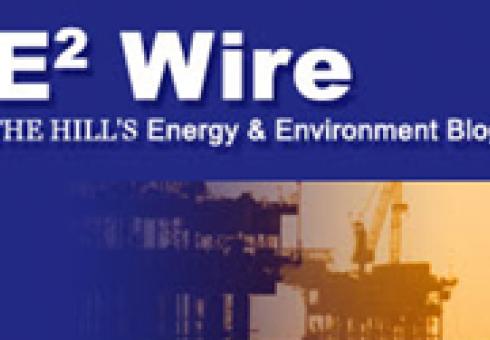News + Media
By: Washington Post/Associated Press
The issue:
People love to talk about the weather, especially when it’s strange like the mercifully ended summer of 2012. This year the nation’s weather has been hotter and more extreme than ever, federal records show. Yet there are two people who aren’t talking about it, and they both happen to be running for president.
Where they stand:
In 2009, President Barack Obama proposed a bill that would have capped power plant carbon dioxide emissions and allowed trading of credits for the right to emit greenhouse gases, but the measure died in Congress. An international treaty effort failed. Obama since has taken a different approach, treating carbon dioxide as a pollutant under the law. He doubled auto fuel economy standards, which will increase the cost of cars but save drivers money at the pump. He’s put billions of stimulus dollars into cleaner energy.
Mitt Romney’s view of climate change has varied. In his book “No Apology,” he wrote, “I believe that climate change is occurring” and “human activity is a contributing factor.” But on the campaign trail last year he said, “We don’t know what’s causing climate change on this planet.” He has criticized Obama’s treatment of coal power plants and opposes treating carbon dioxide as a pollutant and the capping of carbon dioxide emissions, but favors spending money on clean technology. Romney says some actions to curb emissions could hurt an already struggling economy.
Why it matters:
It’s worsening. In the U.S. July was the hottest month ever recorded and this year is on track to be the nation’s warmest. Climate scientists say it’s a combination of natural drought and man-made global warming. Each decade since the 1970s has been nearly one-third of a degree warmer than the previous one.
Sea levels are rising while Arctic sea ice was at a record low in September. U.S. public health officials are partially blaming unusually hot and dry weather for an outbreak of the deadly West Nile virus that is on pace to be the worst ever. Scientists blame global warming for more frequent weather disasters, with the World Health Organization saying: “Climatic changes already are estimated to cause over 150,000 deaths annually.” Others put the toll lower.
Emissions of carbon dioxide and other greenhouse gases from the burning of fossil fuels are trapping more of the sun’s heat on Earth. One study showed that 97 percent of the scientists who publish about climate in peer-reviewed journals say global warming is man-made. So do just about every major science society and institution that has weighed in.
But limiting carbon dioxide emissions from coal and oil would be costly, with billions of dollars in changes to the U.S. economy only a starting point. Similarly the price of not doing anything is extraordinarily high because of costly and deadly extreme weather. People will pay either way in taxes, energy prices, insurance premiums, disaster relief, food prices, water bills and changes to our environment that are hard to put a price tag on, says MIT economist Henry Jacoby.
A NASA study this year found the most extreme type of weather, which statistically should happen on less than 0.3 percent of the Earth at any given time, is now more common. Until recently, the most extreme year was in 1941 when extremes covered 2.7 percent of the globe. From 2006 to 2011 about 10 percent of the globe had that extreme weather, with a peak of 20 percent, the study said. That was before this year’s record extremes started.
The issue of man-made global warming is “totally missing” from the campaign between Obama and Romney, says Jacoby. It should be talked about, he says, because “we’re running a serious risk of passing a much-damaged planet to our descendants.”
Atmospheric science pioneer Susan Solomon speaks on past environmental accomplishments, technology’s role and how history should be our guide to meeting today’s global challenges.
By: Vicki Ekstrom Few can speak with as much authority on the topic of environmental success as Susan Solomon.
Few can speak with as much authority on the topic of environmental success as Susan Solomon.
An MIT professor of atmospheric chemistry and climate science, Solomon was the first to identify the chemical process that causes the ozone hole, and she made some of the first measurements in Antarctica demonstrating that chlorine-containing chemicals that used to be in refrigerators and spray cans are the cause of ozone depletion.
In a Sept. 13 talk, Solomon used the phasing out of these chemicals, known as chlorofluorocarbons (CFCs), as well as the phasing out of lead in indoor paint and gasoline, as successful examples from which the world could learn how to meet today's most critical global challenge: climate change.
VIDEO: Watch the event
CFCs and lead were phased out mainly because of the clear evidence of their danger and strong public understanding of personal health impacts, explained Solomon, who came to MIT last year from the U.S. National Oceanic and Atmospheric Administration and the University of Colorado.
In the case of CFCs, the real reason they were able to be phased out "was because of us," Solomon said.
"Most of these CFCs came from spray cans everyone was using for hairspray and deodorant, so one of the primary sources was literally in your medicine cabinet at home."
When two chemists found that CFCs might deplete the ozone layer and increase risks of skin cancer, "that was enough to get people concerned … [and] it wasn't that difficult to make the change. All you had to do was 'get on the stick,'" Solomon said, parodying a well-known advertisement from that era.
"The key thing that this did was take something that had been very good business and turn it into bad business," Solomon said. To meet the shifting consumer demand, "technological successes were achieved in sector after sector where chlorofluorocarbons were used." Public understanding and action spurred the technological advancements that paved the way to success. But gaining that broad public support isn't always easy.
Public understanding and action spurred the technological advancements that paved the way to success. But gaining that broad public support isn't always easy.
In the case of lead, the trail of scientific evidence warning of health impacts went back as far as the Roman Empire, and perhaps even further. Yet it took many centuries before real action was taken.
"One of the reasons we were slow in doing something about lead was because of scientists who were skeptics," Solomon said, displaying a clear parallel to the climate change issue.
In the end, it was civil rights that spurred public engagement, as poor African American children living in deteriorating housing and near highways were found to have higher levels of lead in their blood, Solomon said.
Solomon also pointed out that the developed world had the infrastructure and institutions to make these changes possible.
"It's easy to knock the EPA these days, but the EPA, FDA, Consumer Product Safety Commission, those are all organizations that we have to thank."
Today's environmental challenge: climate change
Many of the underlying health and human rights concerns from the past are alive today, as the world confronts climate change.
The ethical dimension is especially disturbing, and it's making the problem even more complex and difficult to address. Solomon explained that the average person in the developed world emits a 1,000 times more emissions than the average person in Chad, 200 times more than those in Ethiopia, 80 times more than those in Kenya, and 20 times more than those in India.
"Six billion live in the developing world and they emit about five times less CO2 per person than the one billion of us in the developed world," Solomon said.
At the same time, those countries want to grow and develop. If they choose to grow using fossil fuels like the developed world, global emissions will go up significantly.
"So the key question, the key sustainability issue is, what about those peoples' future?" she said. "Should China pay more to develop than we did? Should Africa?
Such questions aren't sparking the same level of public engagement the world saw before phasing out lead and CFCs, but Solomon thinks they should. "We're in the developed world, we have air conditioning, we have comfortable lives, we have to think beyond us."
"We're in the developed world, we have air conditioning, we have comfortable lives, we have to think beyond us."
While Solomon notes that she personally takes the bus and does what she can to reduce the amount she emits, she's not fooling herself into believing that such actions from everyone will be enough.
"This issue will not be solved by giving up your spray deodorant, this issue won't be solved by taking the bus," Solomon says. "The problem is much bigger."
With no one silver bullet on the horizon, Solomon says research on many different approaches is critical. That could include research on reducing deforestation, increasing wind and solar power, using more efficient cars and building techniques, expanding nuclear, gas and biofuel energy, or employing carbon capture and storage techniques.
To gain this fundamental research and development will require a "bottoms-up technology policy where we start as consumers saying we need a space race for energy technology," Solomon says. "That's what I think we need because engineering and technology has to pave the way. That's why I'm at MIT."
Study estimates rate of intensification of extreme tropical rainfall with global warming.
By: Jennifer Chu, MIT News Office Extreme precipitation in the tropics comes in many forms: thunderstorm complexes, flood-inducing monsoons and wide-sweeping cyclones like the recent Hurricane Isaac.
Extreme precipitation in the tropics comes in many forms: thunderstorm complexes, flood-inducing monsoons and wide-sweeping cyclones like the recent Hurricane Isaac.
Global warming is expected to intensify extreme precipitation, but the rate at which it does so in the tropics has remained unclear. Now an MIT study has given an estimate based on model simulations and observations: With every 1 degree Celsius rise in temperature, the study finds, tropical regions will see 10 percent heavier rainfall extremes, with possible impacts for flooding in populous regions.
“The study includes some populous countries that are vulnerable to climate change,” says Paul O’Gorman, the Victor P. Starr Career Development Assistant Professor of Atmospheric Science at MIT, “and impacts of changes in rainfall could be important there.”
O’Gorman found that, compared to other regions of the world, extreme rainfall in the tropics responds differently to climate change. “It seems rainfall extremes in tropical regions are more sensitive to global warming,” O’Gorman says. “We have yet to understand the mechanism for this higher sensitivity.”
Results from the study are published online this week in the journal Nature Geoscience.
A warm rain will fall
Global warming’s effect on rainfall in general is relatively well-understood: As carbon dioxide and other greenhouse gases enter the atmosphere, they increase the temperature, which in turn leads to increases in the amount of water vapor in the atmosphere. When storm systems develop, the increased humidity prompts heavier rain events that become more extreme as the climate warms.
Scientists have been developing models and simulations of Earth’s climate that can be used to help understand the impact of global warming on extreme rainfall around the world. For the most part, O’Gorman says, existing models do a decent job of simulating rainfall outside the tropics — for instance, in mid-latitude regions such as the United States and Europe. In those regions, the models agree on the rate at which heavy rains intensify with global warming.
However, when it comes to precipitation in the tropics, these models, O’Gorman says, are not in agreement with one another. The reason may come down to resolution: Climate models simulate weather systems by dividing the globe into a grid, with each square on the grid representing a wide swath of ocean or land. Large weather systems that span multiple squares, such as those that occur in the United States and Europe in winter, are relatively easy to simulate. In contrast, smaller, more isolated storms that occur in the tropics may be trickier to track.
An intensity of extremes
To better understand global warming’s effect on tropical precipitation, O’Gorman studied satellite observations of extreme rainfall between the latitudes of 30 degrees north and 30 degrees south — just above and below the Equator. The observations spanned the last 20 years, the extent of the satellite record. He then compared the observations to results from 18 different climate models over a similar 20-year period.
“That’s not long enough to get a trend in extreme rainfall, but there are variations from year to year,” O’Gorman says. “Some years are warmer than others, and it’s known to rain more overall in those years.”
This year-to-year variability is mostly due to El Niño — a tropical weather phenomenon that warms the surface of the Eastern Pacific Ocean. El Niño causes localized warming and changes in rainfall patterns and occurs independent of global warming.
Looking through the climate models, which can simulate the effects of both El Niño and global warming, O’Gorman found a pattern. Models that showed a strong response in rainfall to El Niño also responded strongly to global warming, and vice versa. The results, he says, suggest a link between the response of tropical extreme rainfall to year-to-year temperature changes and longer-term climate change.
O’Gorman then looked at satellite observations to see what rainfall actually occurred as a result of El Niño in the past 20 years, and found that the observations were consistent with the models in that the most extreme rainfall events occurred in warmer periods. Using the observations to constrain the model results, he determined that with every 1 degree Celsius rise under global warming, the most extreme tropical rainfall would become 10 percent more intense — a more sensitive response than is expected for nontropical parts of the world.
“Unfortunately, the results of the study suggest a relatively high sensitivity of tropical extreme rainfall to global warming,” O’Gorman says. “But they also provide an estimate of what that sensitivity is, which should be of practical value for planning.”
The results of the study are in line with scientists’ current understanding of how global warming affects rainfall, says Richard Allan, an associate professor of climate science at the University of Reading in England. A warming climate, he says, adds more water vapor to the atmosphere, fueling more intense storm systems.
"However, it is important to note that computer projections indicate that although the rainfall increases in the wettest regions — or similarly, the wet season — the drier parts of the tropics … will become drier still,” Allan says. “So policymakers may have to plan for more damaging flooding, but also less reliable rains from year to year.”
Susan Solomon, the Ellen Swallow Richards Professor of Atmospheric Chemistry and Climate Science, discusses "The World's Chemistry In Our Hands: Global Environmental Challenges Past and Future" as part of the MIT School of Science's Dean Colloquium Series.
By: Michael Vaughan
Two interesting issues that in the banality of the U.S. presidential campaign will likely never be discussed:
1. the extent of the sea ice covering the Arctic Ocean is now the smallest observed in the three decades since consistent satellite observations of the polar cap began, according to scientists from NASA;
2. an important study finds a carbon tax would enable the United States to find the means to both close the deficit gap and revive the economy.
While the two contenders are slanging each other about tax returns and birth certificates both surely know that NASA and MIT have to be taken seriously. Mitt Romney (not MIT) made his fortune in Boston and Barack Obama went to Harvard. MIT (Massachusetts Institute of Technology) has more new technology patents than most countries on Earth. Harvard has been lucky enough to have had among its alums a well-known billionaire who created Facebook plus eight who have became President of the United States.
When evidence becomes undeniable you have to wonder why those who make big decisions won’t discuss the evidence. Intelligent public policy matters. Yet the news is always obsessed about whether the teachers get their new raise or not. Meanwhile there are policy options that make a huge amount of sense that are never discussed, or even mentioned, in the daily news cycle.
The MIT study found that taxing carbon at $20 a ton in the U.S. would generate $1.5-trillion in revenue in a 10-year period, which would reduce corporate and personal income taxes, maintain social services spending and reduce the deficit.
“With the carbon tax there are virtually no serious trade-offs. Our analysis shows the overall economy improves, taxes are lower and pollution emissions are reduced,” said John M. Reilly, co-director of MIT’s Joint Program on the Science and Policy of Global Change. The study said the carbon tax would lower pollution by 20 per cent by 2050 and prevent oil imports from rising. It would also, most importantly, shift energy markets to clean technology.
Some Republications are coming around to the fact that the United States is facing the expiration of the “Bush” tax cuts in 2013 – the fiscal cliff. Even supply-side economists are reluctantly embracing a fee on carbon emissions. There are many global warming deniers in the GOP but others believe if the U.S. needs to raise revenue, why not just tax global warming pollution? The MIT analysis suggests that a carbon tax would be a more economically beneficial way of raising revenue than payroll or income taxes.
Additionally, the MIT report argues that a carbon tax would accomplish other important objectives. Fossil-fuel use would go down, oil imports would shrink slightly and U.S. carbon-dioxide emissions would decline. A carbon tax is tax levied on all carbon content of fuels. Carbon dioxide is a heat-trapping "greenhouse" gas. Carbon is present in hydrocarbon fuels – coal, petroleum, and natural gas – and is released as carbon dioxide (CO2) when they are burned. In contrast, non-combustion energy sources – wind, sunlight, hydropower and nuclear – do not convert hydrocarbons to CO2.
Yet, even with a carbon tax, the United States would still fall short of its long-term climate goals, which involve an 80 per cent cut in emissions below 1990 levels by mid-century. According to MIT calculations, a modest carbon tax, on its own, wouldn’t get the United States close to that longer-term mark; however, it would still make sense as a more economically efficient way of raising revenue.
If an intelligent public policy can improve the economy, reduce trade deficits, help the environment and keep the U.S. from going broke – why wouldn’t it at least be discussed in the election of the so-called most powerful person on Earth?
MIT researchers have built a model that will be further developed as part of an NSF-funded project to track how chemicals get to remote Arctic environments.
By: Vicki Ekstrom
Listen to researcher Noelle Selin on Alaska's KNOM radio here (segment begins at 3m 42s) It's been more than a decade since global leaders met in Stockholm, Sweden, to sign a treaty with the goal of eliminating persistent organic pollutants making their way into our food chain — such as harmful pesticides like DDT that nearly wiped out the American Bald Eagle. While leaders have come a long way in restricting these types of pollutants, contamination of the Arctic remains a problem. Researchers at MIT are working to help inform policies that more effectively address contamination problems with their latest research and the help of a new grant from the National Science Foundation.
It's been more than a decade since global leaders met in Stockholm, Sweden, to sign a treaty with the goal of eliminating persistent organic pollutants making their way into our food chain — such as harmful pesticides like DDT that nearly wiped out the American Bald Eagle. While leaders have come a long way in restricting these types of pollutants, contamination of the Arctic remains a problem. Researchers at MIT are working to help inform policies that more effectively address contamination problems with their latest research and the help of a new grant from the National Science Foundation.
"Persistent organic pollutants are chemicals of substantial international concern," Noelle Selin, the project's lead researcher and assistant professor in MIT's Engineering Systems Division and Department of Earth, Atmospheric and Planetary Sciences, says. "For emerging contaminants in the Arctic, we need to know more about their sources, environmental behavior, and transport pathways in order to regulate them more effectively."
Selin and Carey Friedman, a postdoctoral associate at the MIT Joint Program on the Science and Policy of Global Change, had their latest results published last week in the journal Environmental Science & Technology. The study, Long-Range Atmospheric Transport of Polycyclic Aromatic Hydrocarbons: A Global 3-D Model Analysis Including Evaluation of Arctic Sources, describes the researchers' development of a detailed 3-D atmospheric model used to track the day-to-day transport of chemicals. Specifically, they tracked PAHs — toxic byproducts of burning wood, coal, oil and other forms of energy that remain in the atmosphere for less time than other persistent organic pollutants regulated by global standards.
"Even though our model estimates lifetimes less than a day, that's still long enough for these PAHs to travel long distances and have potentially damaging effects," says Friedman, the study's lead author, noting that some of these chemicals are known carcinogens that could cause cancer. "So PAHs may be a good case study of how we regulate long-range transport."
Friedman's work will be an important foundation for ongoing work in Selin's research group at MIT, in collaboration with the University of Rhode Island and the Harvard School of Public Health. Together the researchers will be exploring the global transport of other contaminants in the Arctic, such as chemicals used in stain-resistant carpets and non-stick pans. In research going forward, Selin and her team will extend the model created in their recent analysis that allows them to track chemicals with much greater precision.
"These more complex models are showing what simple models aren't, such as daily fluctuations of pollutants in specific locations," Friedman says. "So while the simple models are important for some aspects of the policy process, they may not provide enough information to base these types of important decisions off of."
The presence of these pollutants in the Arctic is important for several reasons. First, the researchers say there's a very real health concern. Organic pollutants typically condense and rain down into Arctic regions. Once they mix with other chemicals, it's unknown what danger they could pose to animals and humans, especially in concert with climate change stressors in the Arctic. Already, these chemicals are known to build up in the fat of whales, seals and other animals — a main source of food for people living in these high latitude regions.
At the same time, the practices that create some of these chemicals such as gas and oil exploration and shipping are expected to increase in the Arctic. As they do, it's important to understand how pollutants traveling from distant sources exacerbate the problem, and how climate changes can affect future contamination.
"Climate change and contaminants are both substantial present and future threats to the Arctic, and our research can ultimately help leaders make better policies to protect this unique environment," Selin says.
By: Kieran Mulvaney
As we approach the peak of this year's hurricane season, one question that is frequently asked - particularly in the wake of this summer's succession of extreme weather events - is whether hurricanes are becoming, or will become, more frequent or stronger as climate change strengthens its grip.
It's a question with which atmospheric scientists have been grappling for a relatively short amount of time, and as such the answer is something of a moving target. Were we to consult a climatological Magic 8 Ball, we might get a response like, ‘Outlook Uncertain, But Becoming Clearer.'
So we decided to do better and turn to one of the foremost authorities on the subject, Professor Kerry Emanuel of the Department of Earth, Atmospheric and Planetary Sciences at the Massachusetts Institute of Technology. Named one of Time Magazine's 100 Most Influential People in 2006, Prof. Emanuel has published extensively on the possible linkages between tropical storms and a warming planet, and he guided us through the complex haze of theory, modeling and observation.
DNews: At the risk of asking you to distill complex science into a simplistic soundbite: Is climate change affecting the number and intensity of cyclones and hurricanes?
Kerry Emanuel: Most of us think that we are seeing a climate change signal in the North Atlantic, which is by far the best observed and has been observed for the longest period of time; but I hasten to add that only about 12 percent of the world’s tropical cyclones occur in the Atlantic. The other parts of the world are not so well observed.
What we expect from a combination of theory and modeling is that as the climate warms, the actual total number of these storms should decline globally, but the incidence of the severe Category 3, 4 and 5 storms is expected on the other hand to go up. And we do see some indication that the proportion of hurricanes that are intense around the world has been going up, although our data is a bit tenuous and is not for very long, so nobody has a great deal of confidence in it.
Let me add that, historically it’s the Category 3, 4 and 5 hurricanes that do the vast majority of damage, at least in developing countries, so those are the ones we’re concerned about the most.
DNews: Is the theory behind this simply that a warming ocean provides greater energy for these storms to feed on? Is that a fair assessment?
Kerry Emanuel: It’s almost fair. What drives hurricanes is the flow of heat from the ocean to the atmosphere, and that is proportional to the difference between the heat content of the two, rather than the absolute temperature in either of them. But it turns out that if you add greenhouse gases to the atmosphere – or indeed, if you were just able to increase the amount of sunlight coming in, one way or the other – that increases the difference and so increases the potential for hurricanes, so that they could become stronger, at least theoretically.
DNews: And what would be the reason for the overall number of storms decreasing?
Kerry Emanuel: This is an interesting question. It bears on a related question, which is, ‘Why don’t we have hurricanes everywhere all the time?’ And the fact is that hurricanes are, fortunately for us, fairly rare. And yet, the conditions for hurricanes are prevalent over much of the tropics through much of the year. We’ve learned in recent decades that what stops most ordinary, run-of-the-mill disturbances from turning into hurricanes is the relative dryness of the atmosphere a couple of miles above the surface. Normally, it’s pretty dry there, but the relevant quantity is the difference between how much water is there, and how much water could be there if the air were saturated, and we call that the saturation deficit. And that deficit increases with temperature.
And because of that, as the temperature gets warmer and warmer, ironically it becomes more difficult to start a hurricane, even though once you start a hurricane, potentially it can become more intense, so you have these two contradictory things going on.
DNews: You mentioned that there is some indication tentatively of some greater intensity in the North Atlantic. Is that a consequence of better data and record-keeping in the North Atlantic, or would one expect a distinction between storms in the North Atlantic and other oceans?
Kerry Emanuel: I wish I could answer that question. I think the data in certain other places, like the western part of the North Pacific Ocean, at times in the past was better than today. We surveyed a lot of those storms with aircraft in the period between about 1945 and 1987, when that stopped for budgetary reasons. And we don’t see such a tight connection between hurricane power and temperature in the western North Pacific that we see in the Atlantic.
We’re not quite sure what is so special about the Atlantic. There are some indications that in the Atlantic kind of an alignment goes on. There are a lot of different things that affect hurricanes, not just temperature. The change in the incidence and intensity of hurricanes in the North Atlantic has been dominated more by temperature, by thermodynamics, whereas in other parts of the world some of these other factors, which are varying quite differently, may be more influential.
I should emphasize that it’s a young science, this connection between hurricanes and climate. We’re making progress and we are beginning to see a consensus developing in certain parts of the problem, but there is still a lot of it we don’t understand.
DNews: You anticipated my next question, which is: is there coming a time when you expect you will have enough of a data set to feel increasingly comfortable with these conclusions?
Kerry Emanuel: Well, the answer is a guarded yes. I think when it comes to the global levels of activity around the world, I can see light at the end of the tunnel, that we may indeed arrive at a consensus. When, on the other hand, it comes down to measures of hurricane activity that people care about – for example, the frequency of landfall of intense hurricanes in North America – whenever you get down to that telescopic level of detail, the models inevitably disagree violently with each other, and so scientists are left without much to go on.
And so when it comes to forecasting the things that people really care about, I don’t think there’s going to be much consensus about that for a very long time. We’re going to form a very strong consensus maybe about things that don’t really matter to people. After all, who really cares how many hurricanes occur in the Atlantic Ocean? We’re really only concerned at the end of the day with landfalling intense storms, and when you get down to that level, all bets are off at the moment.
DNews: My final question then is one you’re probably not comfortable with answering: Assuming a business-as-usual scenario of fossil fuel emissions, do you feel confident in predicting how the intensity and frequency of hurricanes in, say, 2050 might look compared to 2012, or is that a prediction you’re not comfortable with making?
Kerry Emanuel: I’m not comfortable with any predictions. Seeing into the future is pretty tough. I think we have to look at this problem from the point of view of ‘what does society do, and how do we react to this’? As a problem of risk. There’s a rsk that we’re going to have more intense hurricanes. We do know that there is terrific year-to-year volatility with hurricanes; that’s true in the present climate, it will be true in a future climate. So much so that, even if there were a strong global warming signal, we might see it right away in looking at metrics over the entire North Atlantic region, but when we look at metrics that we care about, like hurricane damage – which is caused by a tiny fraction of those events – we would need to wait decades before we see a signal in that.
So we’re in an awkward position. I think hurricane scientists are becoming better and better and better at looking for keys under the lamp, and eventually we’ll find them. But the things people care about aren’t under the lamp, and it will be a long time before we find those.
Let me mention one more thing, and that is that one aspect of hurricanes that people don’t talk about enough is rain. Historically, that’s been a very big killer: for example, the second-most-deadly hurricane in the western hemisphere was Mitch in 1998, and that (deadliness) was entirely due to freshwater flooding. We’ve seen recent examples in the US with Irene last year and Isaac this year. There’s a uniform consensus – one of the few things that we all agree on in hurricane science – that warming the atmosphere will increase the rainfall from hurricanes, and that should be a major concern.
IMAGES:
Hurricane Michael -- seen here on Sept. 6, 2012, with winds of 115 mph, in high resolution infrared imagery from the NOAA/NASA Suomi NPP satellite, was the first Atlantic storm of the 2012 season to reach Category 3 intensity. (NOAA)
Hurricane Isaac video grab (Whitney Shefte/The Washington Post)
By Ari Natter
WASHINGTON, D.C.--A tax on carbon dioxide emissions could raise $1.5 trillion, according to a Massachusetts Institute of Technology report that said the revenue could be used to stave off budget cuts as Congress seeks to reduce a looming federal deficit.
The report, Carbon Tax Revenue and the Budget Deficit: A Win-Win-Win Solution?, released Aug. 27, examined the effects of a carbon tax starting at $20 per ton in 2013 and rising 4 percent annually.
According to the report, such a tax would cut carbon dioxide emissions 20 percent below 2006 levels by 2050, encourage the use of renewables, and reduce oil imports.
“Whether we cut taxes or maintain spending for social programs, the economy will be better off with the carbon tax than if we have to keep other taxes high or cut programs to [rein] in the deficit,” John Reilly, an author of the study and the co-director of MIT's Joint Program on the Science and Policy of Global Change, said in a statement.
Alternative to Tax Increases, Defense Cuts.
The report, which comes as Congress seeks ways to reduce the federal deficit, says the revenue provided through a carbon tax could provide an alternative to tax increases and cuts to defense spending and social programs, and could allow an extension of the Bush tax cuts that are due to expire at the end of 2012.
However, the report's authors warn that “while in principle it is possible to get very positive results from a carbon tax, in practice” it depends on the specific proposal.
One, the Managed Carbon Price Act of 2012 (H.R. 6338), introduced earlier in August by Rep. Jim McDermott (D-Wash.), would place a carbon tax on fossil fuels but would set aside most of the revenues to be refunded to consumers, with the remainder being used for deficit reduction (149 WCCR, 8/2/12).
Still, many analysts remain skeptical that Congress has the appetite to enact carbon tax legislation anytime soon.
Climate legislation that would have required mandatory cuts in greenhouse gas emissions passed the House in 2009, but the Senate version collapsed in 2010.
By: Brad Plumer
With the United States facing the expiration of a slew of tax cuts in 2013—the dread “fiscal cliff”—there has been plenty of interest in offbeat tax-reform proposals. And one idea that a few economists keep knocking around is a fee on carbon emissions. After all, if we need to raise revenue, why not just tax global-warming pollution?
A new paper from the MIT Global Change Institute lays out how a carbon tax might work in practice. The authors model what would happen if, this December, Congress enacted a small fee on carbon emissions to fend off a portion of the tax hikes and spending cuts that are scheduled to occur. The carbon tax would be levied directly on fossil fuels—on coal that comes out of the mine, say, or oil that’s shipped in from overseas—and would start at $20 per ton of carbon in 2013, rising 4 percent each year thereafter.
The authors, Sebastian Rausch and John M. Reilly, estimate that this tax would raise $1.5 trillion over the next 10 years. If that revenue were then used either to cut income taxes, reduce payroll taxes, or deflect cuts to social-spending programs, the MIT authors find, most Americans would be slightly better off than if Congress simply let the fiscal cliff hit, with the Bush tax cuts and payroll tax cuts expiring automatically. (Using the carbon tax in this way would lead to an 0.02 percent bump in consumption and leisure over time.)
Now, the betting line is that Congress will do something to avert the looming tax hikes and spending cuts, so this isn’t a terribly realistic scenario. Implementing a carbon tax next year would still hurt the economy—it would just hurt slightly less than the fiscal cliff. Still, the broader point of the MIT analysis is to suggest that a carbon tax could be a more economically beneficial way of raising revenue than, say, payroll or income taxes. So even if Congress waited until 2014 or 2015 or whenever the U.S. economy has recovered, replacing other taxes with a carbon tax could still provide a minor economic boost (see the first graph below).
A carbon fee usually gets criticized for hurting poorer Americans the most—they spend the biggest slice of their income on gasoline and other energy-intensive products, after all. But Rausch and Reilly found that a lot of the distributional effects depend on what Congress does with the revenue, as shown in the chart below:

CTCorp = carbon tax used to cut corporate tax rate, CTPersInc = carbon tax used to cut income tax rate, CTPayroll = carbon tax used to cut payroll taxes, CTTransfer = carbon tax used to bolster social welfare programs like Medicaid
The green line shows how different income groups would be affected in 2015 if the carbon tax was used to fend off cuts to social welfare programs like Medicaid. Lower-income Americans would benefit significantly, while wealthier Americans would take a small hit. By contrast, the red and blue lines show the effects if revenue from the carbon tax was used to cut the corporate tax or personal income tax—in those cases, higher-income Americans would come out ahead. If, however, a carbon tax was used to cut payroll taxes—that’s the black line—then the welfare effects in 2015 are more or less neutral.
The MIT report argues that a carbon tax would accomplish a few other things as well. Fossil-fuel use would go down, oil imports would shrink slightly, and U.S. carbon-dioxide emissions would decline. On that last point, however, it’s worth noting that the carbon tax proposed by the MIT study only gets the United States a fraction of the way toward its long-term climate targets, as shown in this graph:

Blue line: MIT reference case with no carbon tax. Black line: EIA reference. Green line: Scenario with MIT carbon tax in place.
With the carbon tax proposed by MIT (that’s the green line in the chart above), U.S. emissions would be 14 percent below 2006 levels by 2020 and 20 percent below 2006 levels by 2050. That’s lower than if there was no carbon tax at all.
Yet the United States would still fall short of its long-term climate goals, which involve an 80 percent cut in emissions below 1990 levels by mid-century. According to MIT calculations, a modest carbon tax, on its own, wouldn’t get the United States close to that longer-term mark. It might make sense as a more economically efficient way of raising revenue. But the tax would either have to be hiked dramatically or combined with other clean-energy measures in order to make a significant dent in tackling global warming.
MIT researchers show a carbon tax could help raise the money needed to slash the deficit, improve the economy and secure America’s clean energy future.
By: Zack Colman
Taxing carbon would generate $1.5 trillion, potentially giving politicians cover from making politically difficult decisions on taxes and social spending cuts, according to a study by the Massachusetts Institute of Technology (MIT) released Monday.
A carbon tax would take pressure off Congress to find “tradeoffs” between closing the deficit gap and reviving the economy, according to John Reilly, an author of the study.
“Congress will face many difficult tradeoffs in stimulating the economy and job growth while reducing the deficit,” Reilly, the co-director of MIT’s Joint Program on the Science and Policy of Global Change, said in a statement.
“But with the carbon tax there are virtually no serious tradeoffs. Our analysis shows the overall economy improves, taxes are lower and pollution emissions are reduced.”
The study found that taxing carbon at $20 per ton would generate $1.5 trillion in revenue in a 10-year period. That could be used to reduce corporate and personal income taxes and maintain social services spending, all while reducing the deficit.
The study said the carbon tax also would lower pollution by 20 percent by 2050, compared with 2006 levels, and prevents oil imports from rising. It would also shift energy markets to clean technology, a sector to which the United States has already devoted much capital, the report said.
Sebastian Rausch, an assistant professor of energy economics at ETH Zurich, co-authored the study with Reilly. The study assumed full employment and was based on an earlier Congressional Budget Office report that used a $20-per-ton carbon tax.
Conservatives and liberals alike have recently explored the possibility of a carbon tax.
Right-leaning think tank the American Enterprise Institute (AEI) hosted informal discussions on the topic in July. GOP leadership, however, firmly dismissed the idea of a carbon tax following reports about the AEI talks.
Rep. Jim McDermott (D-Wash.) introduced carbon tax legislation in August, the revenue from which would be used to pay down the deficit and to offset cost increases. That proposal largely mirrors one from Sens. Maria Cantwell (D-Wash.) and Susan Collins (R-Maine).











